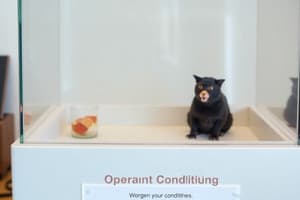Podcast
Questions and Answers
What is the primary purpose of a Skinner Box?
What is the primary purpose of a Skinner Box?
- To observe cognitive learning
- To measure human behavior
- To study classical conditioning
- To conduct response or operant conditioning research (correct)
According to operant conditioning, what happens to behavior that is not reinforced?
According to operant conditioning, what happens to behavior that is not reinforced?
- It is forgotten
- It becomes more frequent
- It remains unchanged
- It becomes extinct (correct)
According to Skinner's concepts, what determines the tendency to repeat a behavior in the future?
According to Skinner's concepts, what determines the tendency to repeat a behavior in the future?
- The individual's personality
- The nature of the behavior itself
- The type of reinforcement used
- The nature of the consequence that follows the behavior (correct)
What is the term for a stimulus that follows a behavior and increases the probability of the behavior occurring in the future?
What is the term for a stimulus that follows a behavior and increases the probability of the behavior occurring in the future?
What is the underlying principle behind operant conditioning?
What is the underlying principle behind operant conditioning?
What is the common thread between operant conditioning and other learning theories?
What is the common thread between operant conditioning and other learning theories?
What is the primary focus of the work of Edward Thorndike?
What is the primary focus of the work of Edward Thorndike?
According to the Law of Effect, what is the result of a response followed by a positive consequence?
According to the Law of Effect, what is the result of a response followed by a positive consequence?
Which of the following is NOT a type of learning theory?
Which of the following is NOT a type of learning theory?
Who introduced the term 'reinforcement' into the Law of Effect?
Who introduced the term 'reinforcement' into the Law of Effect?
What is the common goal of the Healthy Lifestyle, Healthy Schools, and Healthy Environment strategies?
What is the common goal of the Healthy Lifestyle, Healthy Schools, and Healthy Environment strategies?
What is a fundamental concept of the Behavioral Learning Theory?
What is a fundamental concept of the Behavioral Learning Theory?
What is the primary goal of behavioral change through stimulus response or conditioning?
What is the primary goal of behavioral change through stimulus response or conditioning?
What type of learning occurs unconsciously, pairing an automatic conditioned response with a specific stimulus?
What type of learning occurs unconsciously, pairing an automatic conditioned response with a specific stimulus?
What is the term for the stimulus that naturally and automatically triggers a response?
What is the term for the stimulus that naturally and automatically triggers a response?
What is the outcome of appropriate responses being rewarded in behavioral learning?
What is the outcome of appropriate responses being rewarded in behavioral learning?
What is the process by which bonds, connections, and associations are formed in learning?
What is the process by which bonds, connections, and associations are formed in learning?
Which of the following is an example of classical conditioning?
Which of the following is an example of classical conditioning?
Study Notes
- Behavior that is reinforced tends to be repeated and strengthened, while behavior that is not reinforced tends to be extinguished or weakened.
- A Skinner Box is a small chamber used to conduct response or operant conditioning research with animals, typically featuring a lever or key that an individual animal can operate to obtain a food or water reward.
- A reinforcing stimulus, or reinforcer, is a special kind of stimulus that, when encountered after performing a behavior, modifies the tendency to repeat the behavior in the future.
- If a behavior is followed by a reinforcing stimulus, it may result in an increased probability of that behavior occurring in the future, while a behavior that lacks a reinforcing stimulus may result in a decreased probability of that behavior occurring in the future.
- Learning theories are logical frameworks that describe, explain, or predict how people learn, and include types such as Behavioral, Cognitive, and Humanistic.
- Behavioral Theorists include John Watson, Ivan Pavlov, B.F. Skinner, Edward Thorndike, and Albert Bandura.
- B.F. Skinner was influenced by the work of Edward Thorndike, who developed the Law of Effect, which states that a response followed by a positive or pleasant consequence is more likely to be repeated, while a response followed by an unpleasant or negative consequence is more likely to be diminished.
- The Law of Effect is directly a function of the interactions between positive and negative reinforcements and punishments.
- Skinner introduced the concept of Reinforcement, a behavioral change accomplished through stimulus response or conditioning.
- The goal of Behavioral Learning Theory is to become more efficient and realistic as defined by the environment, by creating learning through the formation of bonds, connections, and associations.
- Classical Conditioning is a type of learning that happens unconsciously, where an automatic conditioned response is paired with a specific stimulus, creating a behavior.
- In Classical Conditioning, the conditioned stimulus is paired with and precedes the unconditioned stimulus until the conditioned stimulus alone is sufficient to elicit the response.
- The unconditioned stimulus is one that unconditionally, naturally, and automatically triggers a response, while the unconditioned response is the unlearned response that occurs naturally in response to the unconditioned stimulus.
Studying That Suits You
Use AI to generate personalized quizzes and flashcards to suit your learning preferences.
Description
Learn about the fundamental principles of operant conditioning, including reinforcement, extinction, and the use of Skinner Boxes in research. Understand how behavior is strengthened or weakened based on reinforcement and the role of instrumental learning.




